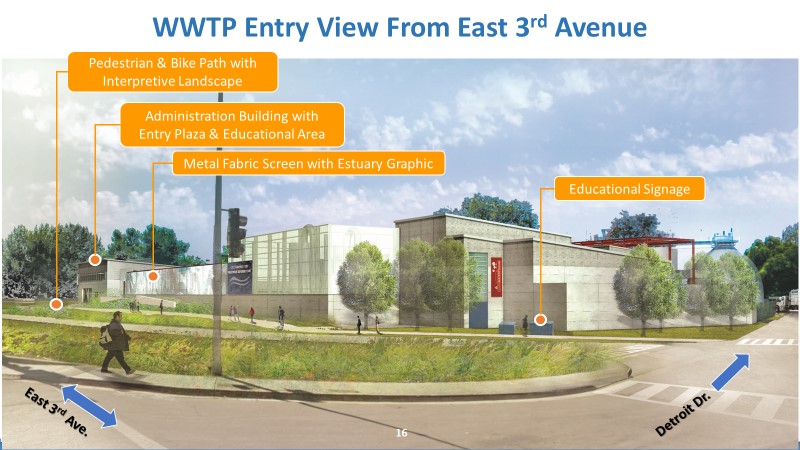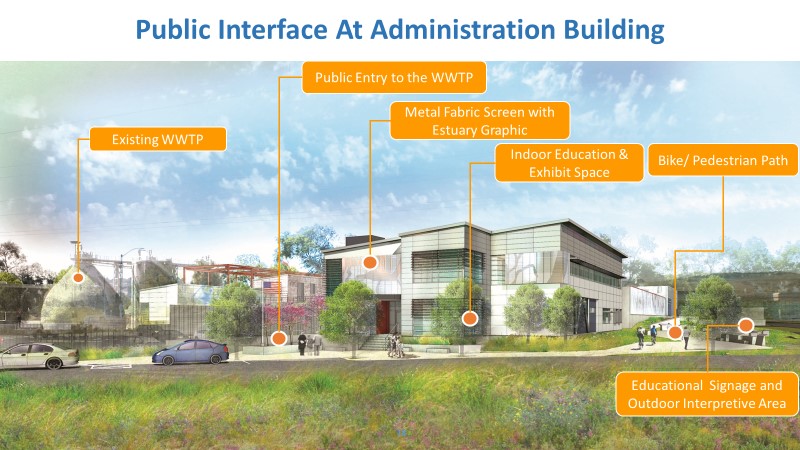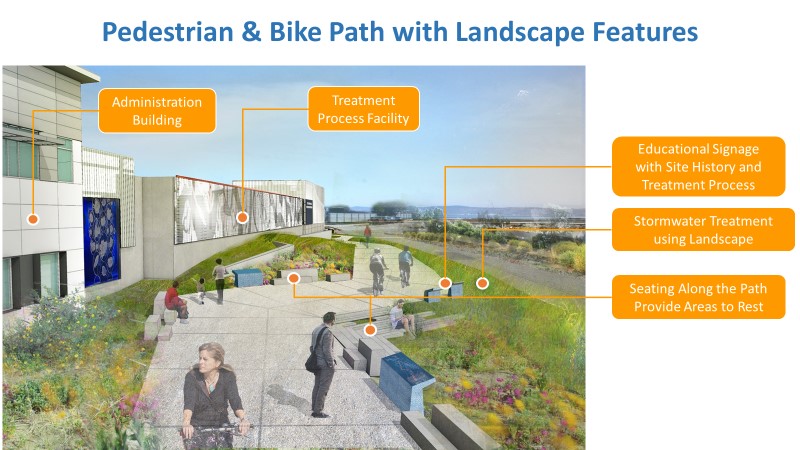Wastewater Treatment Plant Nutrient Removal and Wet Weather Flow Management Upgrade and Expansion Project
Project Description
The Wastewater Treatment Plant (WWTP) expansion project is the largest component of the Clean Water Program, and the most significant rehabilitation work executed at the WWTP since the 1970s. The upgraded WWTP has the capacity to handle heavy storm events up to 78 million gallons per day (mgd). The upgraded WWTP produces high-quality treated water that protects human health and the environment while meeting water quality regulations. In addition to the plant upgrades, a new administration building for operations and maintenance staff was constructed to house the new main control room and laboratory. These facilities are designed to provide advanced treatment that will benefit the City’s residents, the San Francisco Bay Community, and future generations.
Project Schedule
Due to the scale and complexity, the WWTP project is constructed in three phases over six years.
PHASE 1: SITE PREPARATION
Construction Start: July 2019
Construction Finish: Summer 2021
PHASE 2: BUILDING THE FOUNDATION
Construction Start: July 2020
Construction Finish: Winter 2021
PHASE 3: PLANT CONSTRUCTION
Construction Start: September 2020
Finish Construction of New Facilities: September 2025
Finish Improvements of Existing Facilities: May 2026
Project Status
Wastewater Treatment Plant Upgrade Project Update and Upcoming Milestones
The Wastewater Treatment Plant (WWTP) upgrade project continues to achieve important construction milestones and make significant progress. Phase 3 construction activities are nearly complete.
Recent and upcoming Phase 3 plant construction milestones include:
- Existing Plant Chemical Area Improvements Completed – November 2025
- All New Processes Areas Completed – September 2025
- Clean Water Testing – January to December 2025
- Plant Seeding – January 2026
- Plant Performance Testing – July to December 2025
- New Processes Operational – January 3 2026
- l Ribbon Cutting Ceremony held – September 2025
- Conversion of Existing Aeration Basins – January 2026 to March 2026
- Finish All Site Work– May 2026
- Project Closeout – May to June 2026
A ribbon cutting ceremony took place on September 24, 2025, celebrating near completion of the $597M San Mateo Wastewater Treatment Plant (WWTP). The administrative building is expected to be certified Leadership in Energy and Environmental Design (LEED) silver.
The WWTP is the most sustainable facility in the nation serving San Mateo, Foster City, parts of Hillsboro and Belmont as well as Crystal Springs and a portion of San Mateo County. The plant produces the cleanest water discharged to the San Francisco Bay and is designed to withstand sea level rise. The plant protects public health and the environment by preventing sewer overflows during wet weather events, is designed to withstand storm surges, and reduce greenhouse gases and carbon impacts. The project team secured $277M in low interest federal financing saving $20M in interest. The project includes walking and bike paths and public art. The facility will soon be open to the public and schools for educational tours.
The WWTP video that debuted at the ribbon cutting can be viewed here.
Updated December 16, 2025
What Is Happening during the Construction?
During construction, residents can expect parking and pedestrian/biking closures for safety purposes, additional signage in the area, and general construction activities.
Site Safety and Security: Road Closures and Parking Restrictions
The following roads and biking/walking paths will be closed for construction:
- The Dale Avenue walking path is closed for the entire construction period. The pathway from Dale Avenue to the front of the WWTP is scheduled to reopen in late fall 2025. Alternate routes during closures are shown on the below map.
- Public access is permanently closed through Detroit Drive and temporarily closed through Joinville Road. The pathway to/from Joinville Park is scheduled to reopen in late fall 2025. Alternate routes are shown on the below map.
- Public parking on Detroit Drive is permanently closed.
- Public parking on Joinville Road is temporarily closed. Limited public parking will be reopened at the end of construction.
Informational signage will be posted prior to changes in road or path accessibility.

Route Closures and Alternate Routes during Construction
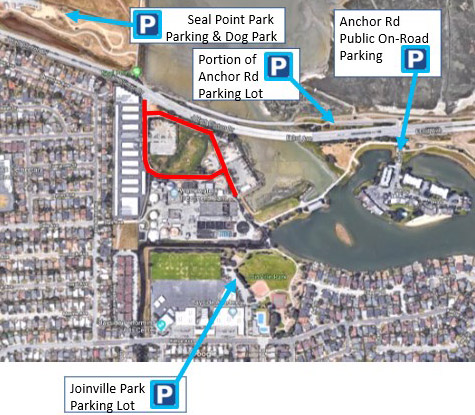
Parking Restrictions and Alternate Parking Facilities during Construction
Construction Hours
Normal work hours will be Monday through Friday 7 am – 7 pm.
Pile Driving work hours will be Monday through Friday 8 am – 5 pm.
Construction work is not planned for the weekends, except in special circumstances or if emergency work is required, subject to City approval. There may be exceptions for work during weekend and holiday hours (Saturday 9 am – 5 pm; Sundays and holidays 12 pm – 4 pm).
Control of Dust and Dirt
Wet-sweeping, covered dump trucks, and rumble strips will be used to reduce dust from construction. The contractor will prevent dust by using an airless sprayer with water for demolition activities. The contractor will use standard dust control measures during construction. Water trucks and sweepers will be dedicated to keeping roadways clean. Trucks leaving with construction and demolition materials will be followed by with a water truck and a sweeper.
Noise, Vibration and Groundwater Monitoring
The contractor is required to use noise-reduction measures during construction, including installation of a sound wall on the western boundary of the site. Trucks and construction equipment will be adequately muffled. Noise will be monitored at various locations throughout the site. Vibration and groundwater levels will also be monitored.

 Traffic Management
Traffic Management
A traffic management plan will be in place for the duration of the project. Construction traffic will be routed from the construction site to the nearest designated haul routes (City of San Mateo Truck Route Program).
Residents can expect approximately 20 to 25 trucks in and out of the construction site per day during Phase 2. Truck trips will occur during regular work hours. The contractor will use the designated City of San Mateo truck routes, shown in the figure.
Construction Hotline
If you have any construction-related questions or concerns, please call the Clean Water Program hotline at (650) 727-6870 or email info@CleanWaterProgramSanMateo.org.

What Is the Wastewater Treatment Plant Upgrade and Expansion Project?
The Clean Water Program is the most significant upgrade to the City’s sewer infrastructure in its modern history. After five years of planning and design, construction is underway on an expansion to the Wastewater Treatment Plant (WWTP). This upgrade is the largest component of the Clean Water Program, and the most significant rehabilitation work executed at the WWTP since the 1970s. Once completed, the WWTP will produce high-quality treated water that will protect human health and the environment while meeting water quality regulations. Improvements will benefit the City’s residents, future generations, and the San Francisco Bay Community. Due to the scale and complexity, the WWTP project will be done in three phases over the next five years.
For information about the Special Use Permit application, please see the Planning Department’s project site here.
In San Mateo, wastewater from homes and businesses is collected by a network of pipes and pump stations. The wastewater is conveyed to the wastewater treatment plant (WWTP), and then treated for discharge to the San Francisco Bay.
In summer, the WWTP treats approximately 11 million gallons per day (mgd) of wastewater. Primary treatment uses gravity to remove solids from the wastewater. Secondary treatment uses biological processes to remove more dissolved waste matter from the wastewater. The WWTP can treat up to 60 mgd per day through primary treatment and 40 mgd through secondary treatment. During heavy rains, the WWTP’s treatment capacity is regularly exceeded. This causes sewer overflows in the collection system. These overflows are a danger to human health and the environment, because they contaminate city streets, creeks, lagoons, beaches, and the San Francisco Bay. Blending of the flows from primary treatment and secondary treatment is sometimes required to manage these high flows and protect the treatment process. In addition to the lack of capacity, many of the existing WWTP facilities and components are more than 40 to 75 years old. Nearly half of the system is reaching the end of its useful life.
The City of San Mateo is currently under a Cease and Desist Order to eliminate sewer overflows. Additionally, our discharge permit requires us to eliminate the blending that occurs under emergency conditions to manage heavy flows, as mandated by the Regional Water Quality Control Board.
The upgrade and expansion project consists of new liquids treatment process facilities, including a headworks, primary treatment, biological nutrient removal/membrane bioreactor process, biological and chemically enhanced high-rate wet weather treatment, and other plant upgrades, including odor control to serve the new facilities. The high-rate wet weather treatment process consists of a biological contact tank and high-rate clarification to provide secondary treatment of wet weather flows to eliminate blending and meet permit requirements. A new administration building for operations and maintenance staff will house the new main control room and laboratory. These facilities will be designed to provide advanced treatment to 21 mgd and allow the plant to better handle heavy storm events up to 78 mgd.
The City selected the design with the best overall value and ability to meet regulations, both now and into the future. The upgraded and expanded WWTP will provide the necessary level of service, protect the environment, and accommodate future population growth. The treated water will be available for landscape irrigation and other reuse purposes.
For information about the Special Use Permit application, please see the Planning Department’s project site here.
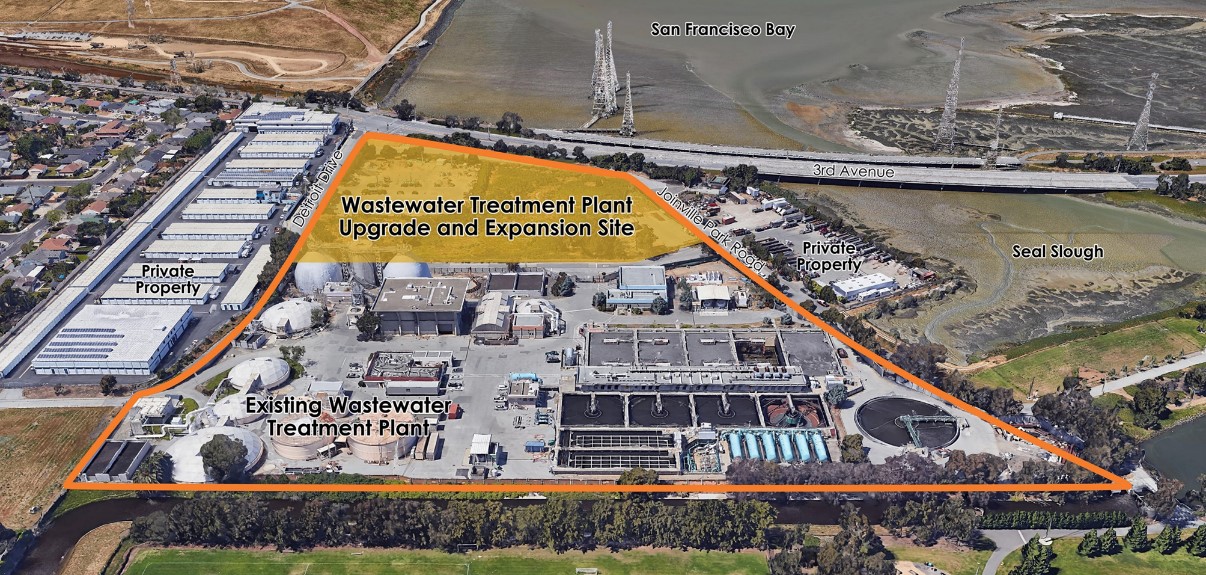

How Will the Plant Improvements Be Built?
The upgrade and expansion work will occur in three phases over approximately 5 years.
Phase 1: Site Preparation
Phase 1 began in July 2019. During this phase, the general construction activities focused on site preparation. The contractor mobilized to the site to set up construction trailers and brought equipment, demolished abandoned facilities on the existing WWTP, excavated, installed perimeter shoring, and installed a dewatering treatment system.
Mitigation measures are in place for dust, noise, and traffic control. Equipment and processes to monitor groundwater levels were installed. Site preparation included the following activities:
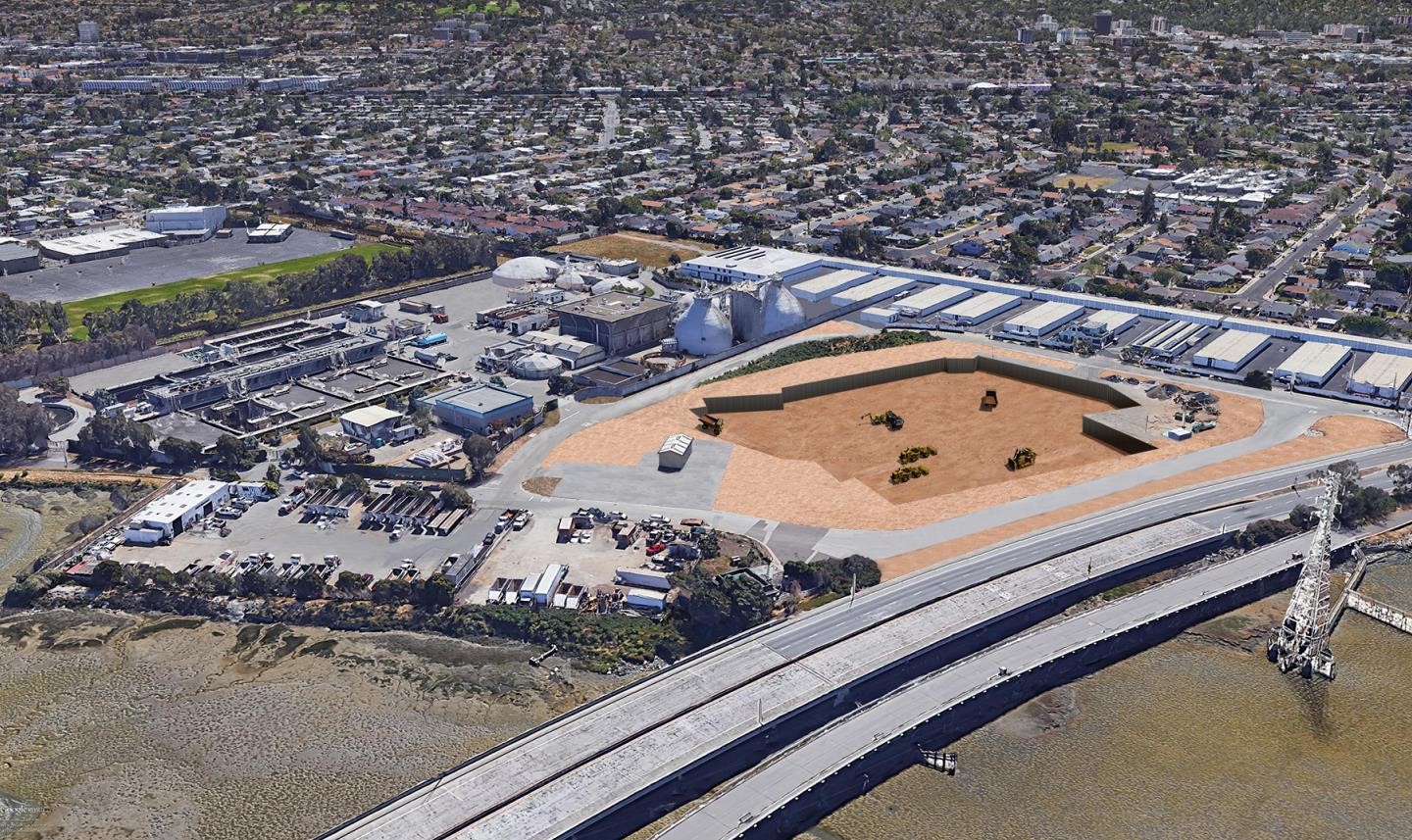 Representation of Site Preparation
Representation of Site Preparation
 Construction-related Changes around the Wastewater Treatment Plant
Construction-related Changes around the Wastewater Treatment Plant
Contractor Mobilization
The contractor mobilized to the site to install temporary fencing to secure the site and setup construction trailers in two locations: on the Detroit Drive parcel and the Dale Avenue parcel. For safety, some changes in public access to the site were made.
Demolition
Demolition of outdated facilities on the existing site occurred during Phase 1 to make space for new facilities and construction staging. The contractor employed low-impact construction methods to minimize noise and dust during demolition. The WWTP will remain fully operational during construction of the new facilities.
Shoring
A shoring system is required to hold the work area open during excavation. A cutter soil mix shoring system was selected to address the challenging soils found at the site. This method cuts the soil while injecting a cement slurry to form soil cement panels. Installation of the shoring system is complete.
Groundwater Dewatering
Once the shoring wall was installed, a groundwater dewatering system was put in place to pump water out of the work area. Groundwater is removed from inside the shoring to maintain stability and is treated prior to discharge to the Bay. The contractor is monitoring groundwater levels outside of the excavation site during construction to maintain the typical conditions beyond the property line. The figure below shows the effects of dewatering from the construction site and groundwater levels.
Excavation
Once the shoring was complete, excavation began and the soil was hauled off-site. Traffic and dust management measures are in place throughout the construction phase.
 Example of Dewatering Method
Example of Dewatering Method
Phase 2: Building the Foundation
 Pile Driving
Pile Driving
During Phase 2, approximately 2,000 foundation piles will be driven to support the new state-of-the-art facility, prevent uplift (floating) from the high groundwater levels, and to keep it in place during seismic events. Pile driving is an important construction method to ensure stability in the Bay mud that underlies the site.
Phase 2 began in July 2020, overlapping with Phase 1. Work in this phase is expected to occur over 18 months. The total expected time to drive all piles is about eight and a half months. The first stage of pile driving is expected to take 6 months starting July 2020 and the second stage is expected to take 2.5 months. There will be a gap of approximately 6 months between the end of the first stage and the start of the second stage.
Noise
Noise levels will vary throughout the duration of the project, depending on pile location and distance from the receptor. Noise reduction and control measures will be in place. During pile driving, a temporary sound wall will be installed on the western boundary of the excavation and pile-driving equipment will be muffled to reduce noise. Noise levels will be monitored during construction and it is expected that pile driving activities will exceed the City’s Municipal Code. Noise tests showed that pile driving during Stage 1 will generate levels exceeding 90 – 100 decibels at the property line, about the sound of a large truck or jack hammer. These noise levels will dissipate as they travel and will be heard at lower levels from the surrounding properties. During Stage 2 some days are anticipated to exceed 110 decibels, about the sound of a rock band. The Project Team conducted a thorough evaluation of pile types, installation methods, noise abatement techniques, and construction scheduling to mitigate impacts to the extent feasible and obtain the necessary noise exceptions from the City Manager.
These mitigation measures are being implemented to limit noise during pile driving:
- Restricted hours for pile driving (8 am – 5 pm on weekdays only)
- Use of a hydraulic hammer
- Use of a noise-reducing shroud (sound absorbing material) on the hydraulic hammer
- Temporary sound walls to absorb sound
- Use of a second pile driving rig, when feasible, to shorten the overall duration
Vibration
We do not anticipate residents feeling any vibration from the pile driving activities. Test piles were driven at the project site in 2018 and vibration was monitored at various locations. During the testing, very low levels of vibration were detected at the project site and these levels were found to attenuate significantly. While no significant vibration issues were found associated with this activity, vibration monitoring will be performed during pile driving to monitor any potential vibration impacts. If levels exceed acceptable limits, the pile driving will be suspended, and the activity will be re-assessed.
Groundwater Monitoring
Construction dewatering began in 2020 and will be used as-needed until 2022.
Groundwater level observation wells located on the perimeter of the construction site continuously monitor groundwater levels. Periodic surveying of the surrounding project area is being conducted to monitor potential ground settlement. These were done prior to the start of pile driving and will be done during and upon completion of the project.
Phase 3: Plant Construction
Phase 3 will involve the construction of the new treatment facilities and the administration building. Street and landscape improvements will be built, and the contractor will demobilize from the site. Phase 3 began in June 2020, overlapping with Phase 2. Additional community updates will be provided before the start of Phase 3.
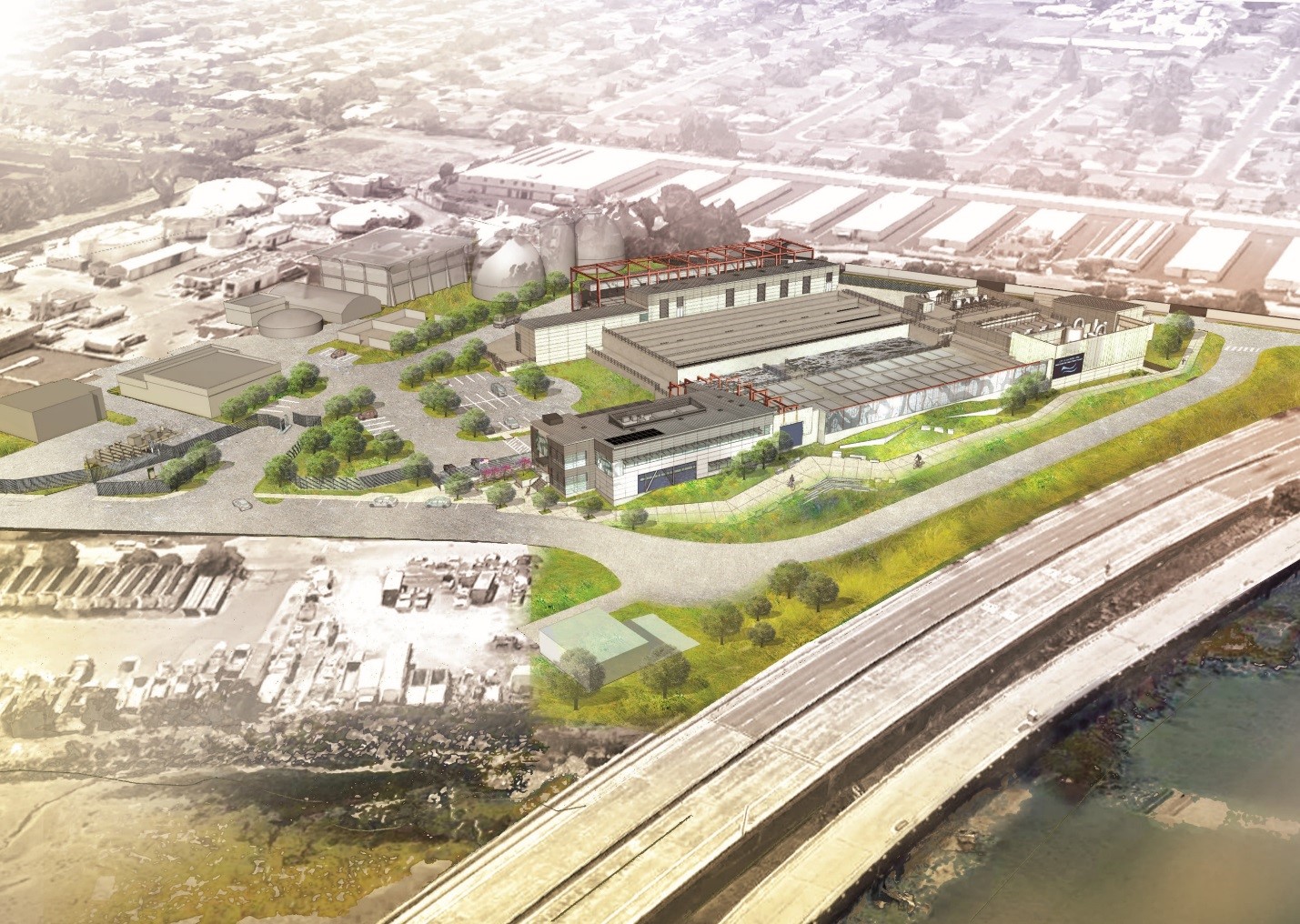 Representation of Completed Facility
Representation of Completed Facility
California Environmental Quality Act Compliance
A Programmatic Environmental Impact Report (PEIR) was prepared and adopted by the City Council in July 2016. The PEIR included measures to minimize impacts on residents and local ecosystems.
- The Final Programmatic Environmental Impact Report for this project is available here. Hard copies are also be available at City Hall, the San Mateo Main Library, and the Hillsdale Branch of the San Mateo Public Library.
- A Final EIR, incorporating written responses to comments received during the public comment period, was certified by City Council on June 6, 2016. The City prepared addenda that were approved on July 16, 2018 (Addendum 1) and April 15, 2019 (Addendum 2).
What Are the Community Benefits of these Improvements?
In addition to treating wastewater and protecting human health, the plant design incorporates features to serve as a community asset. The front edge of the plant will have improved visual aesthetics and be landscaped with a native grassland to balance the built and natural elements. The grassland will treat the site’s stormwater naturally. This natural system reflects the historical marshes that treat and filter water along the bay.
A meandering pedestrian path will allow the public to walk or bike beside the treatment plant and through the re-created natural area. Educational signs will be located along the path to inform the public of the ecological processes in the landscape and the treatment processes occurring in the plant. The path will cross the bioretention areas and continue to the new administration building, which will have an educational area and serve as the public interface for the plant. From the administration building, the path will continue south to the parks, dog park, and school beyond the plant. The landscape design will provide pedestrian access along the treatment plant with educational demonstrations and connectivity between surrounding neighborhoods and the Bay Trail.
